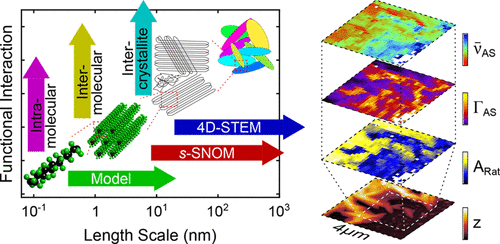Multidimensional nano-imaging of structure, coupling, and disorder in molecular materials
| Reviews and Highlights | Quantum Science | Molecular and Soft-matter | Ultrafast Nano-optics and Nanophotonics | Mineralogy and Geochemistry |
|---|
Sven A. Dönges, R. Peyton Cline, Steven E. Zeltmann, Jun Nishida, Bernd Metzger, Andrew M. Minor, Joel D. Eaves, and Markus B. Raschke
Nano Lett. 21, 6463 (2021).
DOI PDF SI

A hierarchy of intramolecular and intermolecular interactions controls the properties of biomedical, photophysical, and novel energy materials. However, multiscale heterogeneities often obfuscate the relationship between microscopic structure and emergent function, and they are generally difficult to access with conventional optical and electron microscopy techniques. Here, we combine vibrational exciton nanoimaging in variable-temperature near-field optical microscopy (IR s-SNOM) with four-dimensional scanning transmission electron microscopy (4D-STEM), and vibrational exciton modeling based on density functional theory (DFT), to link local microscopic molecular interactions to macroscopic three-dimensional order. In the application to poly(tetrafluoroethylene) (PTFE), large spatio-spectral heterogeneities with C–F vibrational energy shifts ranging from sub-cm–1 to ≳25 cm–1 serve as a molecular ruler of the degree of local crystallinity and disorder. Spatio-spectral-structural correlations reveal a previously invisible degree of highly variable local disorder in molecular coupling as the possible missing link between nanoscale morphology and associated electronic, photonic, and other functional properties of molecular materials.
